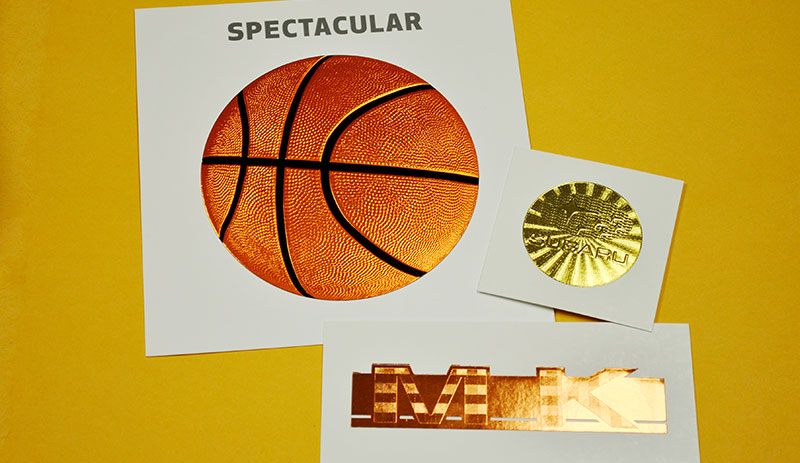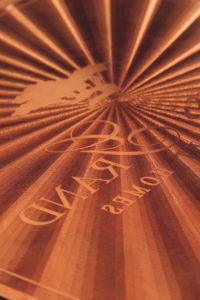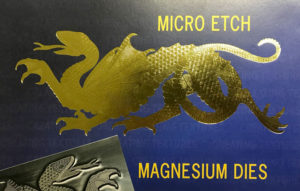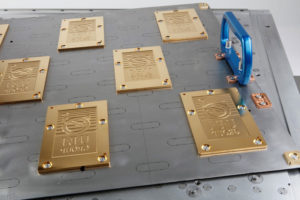
By Jeff Peterson, executive director
FSEA

Determining the right type of engraving(s) for a specific job is much more complex than simply placing an order over the phone to the chosen engraver. Engraving technology, as with every type of manufacturing, has changed tremendously over the last several years. If finishers, greeting card and folding carton manufacturers, and others are not taking advantage of these technology changes, then they may be adding unnecessary costs with the die(s) or by not utilizing other product offerings that can help save significant time on and off press.
Refractive (micro-etched) engravings
Refractive dies can be known by several names, including micro-etched, double-etched, refractive, micro-embossed and other trade names. So, it becomes somewhat confusing for the foil stamper when offering this technology to customers and ordering the dies from the engraver. It is important that foil stampers understand the technology and the differences in how the dies are made. Refractive dies can be produced in different ways, but the finished product is virtually the same. “Most engravers offering refractive dies have a library of patterns, both linear and circular, that can be centered on the image however the customer chooses,” said Metal Magic Vice President of Sales Mark Schumacher.
Refractive engravings can be produced through the use of standard patterns offered by the engraver (which is less expensive) or multiple patterns can be used to create a custom refractive effect with the desired image. “We can create custom patterns for customers for unique personalized looks and security enhancements,” stated Greg Faddis, direct sales and technical support with UEI Group. “We also have new patterns for specific industries, such as food and beverage.”

Refractive engravings are most commonly chemically etched into copper, but they can be produced in magnesium and brass as well. “We have seen an increase in requests for micro-etched magnesium,” added Doug Pendergast, national account director of Owosso Graphic Arts. “Customers can choose from a library of textures or supply their own patterns.”
The same type of etched engraving also can be produced utilizing CNC technology, and many are not aware of this option. “A CNC-engraved ‘micro-embossing’ produces the same type of refractive or double-etched engraving as one chemically-etched into copper or magnesium,” explained h+m USA General Manager David Bohne. Using CNC-engraved micro-embossing dies can be an excellent choice for high-volume or repeat jobs where the life of the die is of utmost importance.
Foil stampers should have a book of samples that illustrates how a refractive image can look on all types of printed materials. It is difficult to sell the use of refraction without the customer seeing true examples. Engravers have libraries of patterns and should have additional samples to showcase to potential customers.
A refractive image can be a cost-saving choice when compared to a multi-level emboss or an image utilizing holographic foil. “This effect can be more cost effective than holographic foils because you have a one-time fixed die cost vs. an increased unit cost incremental to the run rate using higher-end foil,” remarked Bohne. “However, refractive dies offer a different effect vs. holographic and therefore it depends on the taste of the company seeking a suitable brand identity.”
“Refraction can be a great alternative to sculptured embossing dies from a cost standpoint, but it really comes down to the desired look,” added Faddis. “The same can be said for using refraction vs. holographic foil.”
CNC engravings

The process of creating chemically etched and hand-sculptured engravings dates back decades, but the newer use of CNC technology to create dies is becoming a popular choice, especially for multi-up larger foil stamping jobs where consistency from die to die is very important. “Time and the ability to reproduce exact duplicate dies from one to the next are the key factors in using CNC over a hand-sculptured engraving,” stated Metal Magic’s Schumacher. “On the other hand, if the image is only one-up and will probably never be run again, then a hand-sculptured, multi-level engraving may be the best choice.”
Although CNC-engraved brass dies are perceived to be more expensive – and, in most cases, with an initial order – foil stampers need to look long term to determine if they are a good investment. “For high run rates and repeat jobs, there can actually be a cost savings,” remarked Bohne. “Due to the longevity of brass engravings, CNC-engraved dies have the ability to maintain superior, crisp edges for one million plus impressions.”
Faddis pointed out that it is best to let the engraver determine which manufacturing process is most desirable for the die – given that each engraver can offer different options. CNC brass dies certainly have their place in the decision process. “CNC technology has come a long way since it was first introduced,” continued Faddis. “Every engraver is different in its capabilities and technology.” Faddis also explained that foil stampers should look carefully and choose an engraver committed to making significant investments in improving their capabilities and technology.
Other suggestions
Planning ahead is key in saving costs with engravings. For instance, some engravers will provide a savings to the customer if multiple dies can be requested in one order. “Ganging a group of images is one of the biggest areas of cost savings when it comes to dies for our Owosso customers,” stated Pendergast. “For example, eight 4″ x 2″ images that can be ganged together can save the customer an average of 50% on die costs vs. the same dies run individually.”
For larger foil stamping jobs, it can be beneficial to incorporate a lock-up system that not only provides high-precision engraved dies and pre-cast counters but also saves valuable time in locking up the dies on press. “UEI Group has developed several lock-up solutions for customers,” explained Faddis. “These types of systems can reduce lock-up time down to minutes, improve production runs and lower overall costs.” Just as it is important to analyze the overall long-term cost of an engraving, it also is important to calculate the potential savings of a lock-up system on press. For large format foil stampers where many of the jobs include multiple-up dies, a lock-up system or chase replacement system can be invaluable.
With large sheet formats that include a multi-level embossed image, the cost of the dies can become prohibitive. Metal Magic has developed a method of producing duplicate dies (dupes) that has come a long way from the original process.
“The dupes that we provide are flat, hard and can last tens of thousands of impressions,” said Schumacher. “It is very difficult to see the difference in the impression of a duplicate die vs. an impression made with a brass die – and the cost savings using dupes can be quite significant for certain jobs.”
Because most die costs are calculated by the square inch, any creative ways to minimize the size of the die can provide significant savings to the foil stamper. “Rather than ordering one die that may have two or three images on it with a great deal of blank area, there can be creative ways to break down the die into smaller pieces for each image area,” explained Bohne. “The downside is the slightly extra time to register additional dies on press.”
However, Bohne went on to explain that a lock-up system with the dies pre-set on a carrier plate can help defer this extra set-up time with additional dies.
The key to choosing the right engraving and maximizing cost savings is communicating with the engraver to make sure all the details of the job are understood. In addition, foil stampers need to look long-term when evaluating die costs and other costs involved with set-up and makeready. This can play into the type of die selected and the decision to be made if some type of lock-up system should be used on press. Keeping costs down is more important than ever with smaller margins. Knowing all of the engraving choices and choosing the right one is an efficient way to start.

